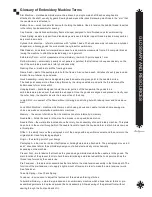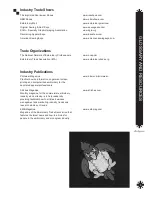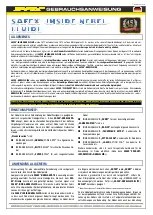
G
LO
S
S
A
R
Y A
N
D R
ES
O
UR
C
ES
4
Glossary of Embroidery Machine Terms
Arm Machine – multihead embroidery machine driven by a single main shaft. Each sewing head is
attached to the shaft, usually by gears. Sewing heads resemble industrial sewing machines in the “arm” that
the needle case is attached to.
Bobbin Case – small, round metal device for holding the bobbin. Used to tension the bobbin thread. Inserted
in the rotary hook assembly for sewing.
Cap Frames
– specialized embroidery frames (hoops) designed to hold finished caps for embroidering.
Check Spring- assists in upper thread tensioning and is used to detect upper thread breaks in many embroi-
dery machine models.
Cylinder Arm Machine – refers to machines with “cylinder” beds. The hook assembly is housed in a cylinder-
shaped arm, allowing goods to curve around the cylinder for embroidery.
Disk Reader – an external or internal device used to read machine movements from a 3.5 computer disk al-
lowing the machine to stitch the selected design on a garment.
Embroidery Point – unit of measurement in embroidery, in which 10 points equals 1 mm.
Flat Embroidery – embroidery (usually on cut panels or patches) that is framed in hoops exclusively on the
top of the embroidery machine’s rotary hook assembly.
Framing Press – machine to aid the framing process.
Frame Sash – part of the pantograph to hold the frames. Also called a sash. Varieties of sash types include:
Border, frame, tubular, cap and sock.
Hook Assembly – rotary device designed to pass the needle at a given point in the needle bar rise.
The hook point passes into a thread loop formed by the rising needle bar and pulls the thread around the
bobbin case to form a lock stitch.
Hooping Board – board designed to hold the outer portion of the hoop while the goods to be
embroidered are placed over the board to be hooped. Once the goods are aligned and placed correctly over
the outer hoop, the operator inserts the inner portion of the hoop.
Jump Stitch – movement of the frame without trimming and stitching but with take-up lever and hook move-
ment.
Lock Stitch Machine – machine which forms a stitch using a hook and needle. Includes home sewing ma-
chines, as well as computerized embroidery machines.
Memory – the amount of stitches that the machine can store internally in memory.
Needle Bar – holds the needle in the machine; moves in an up and down motion.
Needle Plate – the metal plate located above the rotary hook assembly of an embroidery machine. This plate
has a hole in the center through which the needle travels to reach the hook and form a stitch. Also known as
a throat plate.
Offset
– the ability to move the pantograph out of the design with a specific movement and then return to the
original point. Used for placing appliqués.
Origin – the starting point of your design.
Pantograph
– a bar, rack or holder that frames or holding fixtures are attached to. The pantograph moves in X
and Y directions to form the embroidery design, controlled electronically or mechanically
depending on the machine.
Presser Foot – metal device that touches the goods being embroidered while the needle is in the goods. The
main function of the presser foot is to hold the material being embroidered until the hook point catches the
thread loop formed by the needle rise.
Pre-Tensioner – thread tension assemblies that are before the main tension assembly in the thread path. The
function of the pre-tensioner is to apply a light amount of tension in order to make the main tensioner work.
See Tensioner.
Take Up Spring – See Check Spring.
Tensioner – device used to adjust the tautness of thread when forming stitches.
Tubular Embroidery – embroidery produced on an embroidery machine which allows tubular fabric or pre-
assembled garments to be placed around the hook assembly. Allows sewing of the garment front without
sewing through the front and back of it.
Summary of Contents for GS1501
Page 30: ...GETTING STARTED 28 ...
Page 31: ...GETTING STARTED 29 The Control Panel Display ...
Page 62: ...EMBROIDERY BASICS 28 Notes ...
Page 64: ...MACHINE BASICS 2 ...
Page 65: ...MACHINE BASICS 3 ...
Page 70: ...MACHINE BASICS 8 ...
Page 71: ...MACHINE BASICS 9 ...
Page 78: ...MACHINE BASICS 16 Notes ...



































